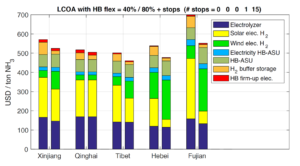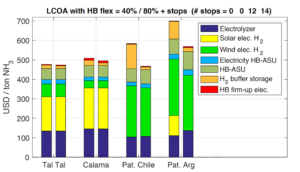IEA Completes Two Power-to-Ammonia Reports
By Stephen H. Crolius on May 03, 2019
The International Energy Agency has completed two reports that examine the economics of hydrogen and ammonia production based on wind and solar electricity generation. Both reports were written by IEA Consultant Julien Armijo under the supervision of IEA Senior Analyst Cédric Philibert. One focuses on China and formalizes the findings and conclusions that were the subject of a February 2019 Ammonia Energy post. The other focuses on Chile and Argentina. Both reports cast an encouraging light on the near-term cost-competitiveness of green ammonia vs. conventionally produced brown ammonia in specific national markets.
The China report – Perspectives for H2 and NH3 production from combined variable solar and wind energy in China – opens by stating the general relevance of the topic:
Green hydrogen production via water electrolysis is the paradigm of industrial conversion of renewable electricity into clean fuels and feedstock, i.e., chemical energy, storable and transportable. As such, it is a rapidly emerging technological route able to unleash the vast potential of variable renewable energies (VRE), especially wind and solar, way beyond electricity, and pave the way for realistic planning of a global economy with net zero emissions. The production of renewable fuels (hydrogen, and hydrogen-rich molecules) is a powerful variability “eraser”, because unstable intermittent electricity is directly converted to stable and dispatchable energetic molecules and feedstock . . .
Julien Armijo, Perspectives for H2 and NH3 production from combined variable solar and wind energy in China, International Energy Agency, March 29 2019
Subsequently the report describes the specific relevance green ammonia might have in China:
China is the largest producer [and] consumer of ammonia, urea and ammonium nitrates in the world. It produces about 50 Mt NH3/yr, that is, almost 30% of the global production of 180 Mt in 2016 . . . Since about 70% of ammonia in China is derived from coal, 10% from oil products and 20% from natural gas, the possibility to achieve strong abatements of CO2 emissions are very large . . . The CO2 intensity of coal-based ammonia and methanol is, respectively, more than two and half times and almost five times that based on natural gas-based routes.
Julien Armijo, Perspectives for H2 and NH3 production from combined variable solar and wind energy in China, International Energy Agency, March 29 2019

Each report provides a complete description of the methodology behind the economic modeling. Of note is the high-resolution approach taken to the question of variability in the wind and solar resources. Hourly data for an entire annual cycle was assembled for each site. This does justice to both daily patterns of sunshine and wind, and to their season-by-season variations.
The detailed analytic approach allows the effects of important cost drivers to be quantified. Among the key factors are the amount of hydrogen buffer storage deployed between the electrolyzer farm and the Haber Bosch plant, and the degree of flexibility in loading the Haber Bosch plant. Both factors turn out to have powerful impacts on one of the exercise’s motivating questions: is there benefit in locating green ammonia production in places that are strong in both solar and wind resources?
The answer is “to some degree, usually.” Each report presents results for two distinct locations. Plant flexibility in each case is stipulated as “normal,” i.e., loading levels that vary between 60% and 100% of nameplate capacity. As detailed in the South American report, Perspectives for H2 and NH3 production from combined solar and wind energy in northern Chile and Argentinian Patagonia, a cost advantage of 15% accrues from the overlap or “hybridization” of solar and wind resources in Argentine Patagonia. For the Tal Tal site in Chile, the advantage is 6%. For a Tibetan site in China, the advantage is only 2%. But for a site in Hebei Province, it is 18% relative to a scenario of solar only and 21% relative to wind only. The Hebei analysis is used to demonstrate the interdependence between hybridization and Haber Bosch loading flexibility. When the loading range is increased to 80% (between 20% and 100% of nameplate capacity, with the possibility of “cold stops”), the advantage that accrues to hybridization shrinks to 3%.

In the end the reports validate the intuitive rationale for hybridizing: “The gain by hybridization comes essentially from its ability to ‘regularize’ the variability of the dominant VRE resource: wind brings power in the night, and solar blending reduces the fluctuations from an only wind starting point.”
All of the analysis might be of merely academic interest were it not for the bottom line drawn by the reports. In both the Chilean/Argentine and Chinese ammonia markets, it appears that ammonia produced from variable energy resources is on the verge of cost-competitiveness with the brown commodity.

In Chile and Argentina, “this work shows that, under realistic near term assumptions, in these locations that all boast world-class wind or solar, green H2 and NH3 could be soon produced at costs almost competitive with the traditional fossil fuel alternatives . . . LCOA below 500 USD/ton [is] already comparable to the 300-600 USD/ton market value of NH3 from SMR in Chile.”
In China, “ammonia production at less or around 500 USD/ton is achievable in near term from the best wind and solar resources . . .”
Considering the economies of scale expected if electrolysers are deployed massively, and more importantly, the expected upcoming cost reductions of solar and wind energy, the production of green H2 and NH3 is a well-identifiable business cases in China in the short term, and a very relevant path for rapid, strong and scalable climate action, considering in particular the emissions of 4 ton CO2/ton NH3 for the vast majority of the current coal-based ammonia production in China. Factoring-in the climate benefits or possibly increased carbon taxes would make the case even more compelling.
Julien Armijo, Perspectives for H2 and NH3 production from combined variable solar and wind energy in China, International Energy Agency, March 29 2019